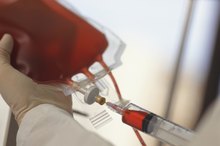What does fact checked mean?
At Healthfully, we strive to deliver objective content that is accurate and up-to-date. Our team periodically reviews articles in order to ensure content quality. The sources cited below consist of evidence from peer-reviewed journals, prominent medical organizations, academic associations, and government data.
The information contained on this site is for informational purposes only, and should not be used as a substitute for the advice of a professional health care provider. Please check with the appropriate physician regarding health questions and concerns. Although we strive to deliver accurate and up-to-date information, no guarantee to that effect is made.
Blood is typed according to the antigens, or factors that promote an immune response, on the red blood cells. Matching the blood by type and Rh factor of a donor and recipient greatly reduces the possibility of a serious allergic reaction to the foreign blood.
Type O
Blood types include A, B, AB, and O 2. Types A and B have antigen A and antigen B, respectively, on the surface of their red blood cells, and Type AB blood has both A and B 2. Type O blood has neither antigen.
Rh Factor
About O Positive Blood
Learn More
Blood is also classified by the presence or absence of another antigen called the rhesus or Rh factor. O positive blood has the Rh factor, but neither antigens A or B; and O negative blood lacks the Rh factor as well as antigens A and B.
Donation
People with an O negative blood type are sometimes called “universal donors” because their blood has no antigens that would cause an allergic reaction in a recipient of another blood type 1. However, doctors would only use unmatched blood in an emergency.
Frequency
The History of Blood Testing
Learn More
According to the Red Cross, O positive is the most common blood type across all ethnic groups 2. O negative blood is relatively rare.
Related Articles
References
- Mayo Clinic: Universal Blood Type Donor
- Red Cross: Blood Types
- Sahu S, Hemlata, Verma A. Adverse events related to blood transfusion. Indian J Anaesth. 2014;58(5):543–551. doi:10.4103/0019-5049.144650
Writer Bio
In 20 years as a biologist, Susan T. McClure has contributed articles to scientific journals such as "Nature Genetics" and "American Journal of Physiology." She earned her Ph.D. from the University of Maryland. She enjoys educating people about science and the challenge of making complex information accessible.








